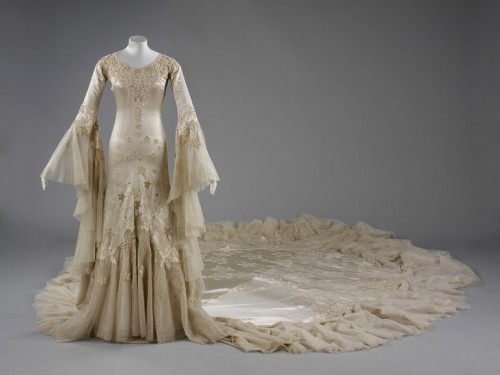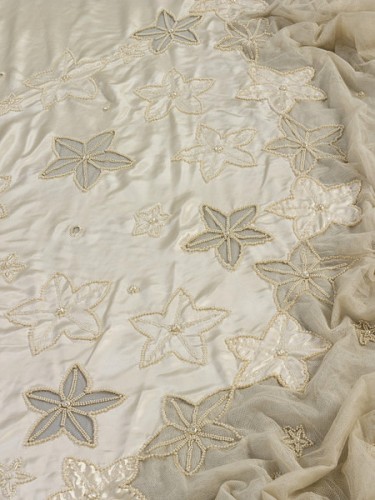A few days ago I was lucky enough to be invited to a very special media event at Te Papa in conjunction with Unveiled: 200 Years of Wedding Dresses.
At the event we oversaw the opening of the crate containing the spectacular 1933 Norman Hartnell dress worn by Margaret Whigham, later Duchess of Argyll (yes, that Duchess of Argyll) for her first wedding.
The whole media event is part of a wider movement in the museum world to ‘de-mystify’ museums – to allow the public to see a little of what goes on to make exhibitions happen, and to display fragile objects. It’s a movement I heartily approve of: I feel the more we know about historical objects, the more we will feel connected to them and responsible for their care.
I’ve worked in museums, and been intimately involved with the transport of objects and exhibition install, but the wonder of seeing an exquisite, fragile, quite old object travel huge distances and go on display never fails to thrill me. Every time is a privilege, and I hope I can share some of that with you.
So how exactly do you transport an 80 year old silk charmeuse and tulle confection covered in beads with a 5.5 metre train halfway across the world?
Really, really carefully, in a custom made crate!
First the whole dress, on its purpose built mannequin, is placed on a support board that will travel with it. The dress gets wrapped in custom-made silk habotai covers which drape over the dress without ever resting on it. The mannequin hands and the beaded areas are supported with padding, and the train is placed in a padded ‘sandwich’ which will protect the beading and keep it from creasing. The whole thing is then covered with tyvek, a static-free, acid-free, breathable but moisture and dust resistant museum fabric.
The train, in its supportive, protective ‘sandwich’ cover with outer tyvek layers, is then carefully lifted up and draped over two trestles, so that it doesn’t take up 5.5 metres of travelling space, but is completely supported for the transit and doesn’t fold or crease. The V&A affectionately call the arrangement of trestles “the toast rack”!
With the dress all wrapped and padded for its journey, it is ready to go in its crate. The support board is then picked up with a special dolly, and carefully slotted into a crate that will have been built to an exact set of dimensions. The top of the mannequin slots into a series of blocks fastened to the top of the crate, and the bottom of the mannequin is supported by blocks on the support board, so that the whole thing can’t wobble or move in any way.
Unfortunately I didn’t get photographs at the event, but Te Papa has a flickr set of the exhibition install, including this one of the wrapped dress with the train on the ‘toast rack’. And the Dominion Post has a few photos too.
Most museum objects are accompanied by an expert (a curator, collection manager, conservator, or museum courier, depending on the object and museum) from the museum that the object belongs to when they travel. Their job is to make sure that the items are safe on the trip, and to help unpack and install them when they arrive. Keira Miller from the V&A accompanied the Hartnell dress (and all the other drool-worthy wedding gowns in the exhibition), and talked us through the un-packing of the dress.
When the dresses arrived at their destination the whole packing process gets reversed, and that’s what I got to see. The train very, very carefully lifted off the ‘toast rack’ (that’s me in the black and white), the wrappings come off one by one, the hands get unwrapped, everything gets straightened and smoothed, the top of the mannequin goes back in, and then the fun begins.
The fun is condition reporting.
Every single inch of the dress is gone over: every single pearl bead is counted, and any changes in condition are noted. I’m not kidding. They literally have diagrams of the dress that note the tiniest pull, and a single missing bead, so that anything new can be documented.
The condition reporting makes me think of all the unnamed seamstresses who spent weeks labouring over the dress in 1933 for their paltry share of the 53 pounds it cost Margaret. Their actions mirror each other: heads down, focused on each minute pearl, following the inverse and reverse appliqued stars around the hem of the dress. So much care and love from both parties. All so that we can enjoy the dress, and enjoy their work and effort and artistry long after the wedding.



53 pounds???!!! Lord love a duck that’s a bargain! Let me see…a good salary for a working class man then was about 5 pound a week so roughly, it’s about 5,000 pounds now? That would seriously not buy any designer wedding dress of scale. Even 10,000 wouldn’t. Things have moved on all right.
How exciting to be there!
That is one of the most beautiful dresses I have ever seen. I’m glad they’re taking such good care of it!
Can we rate THIS dress?! 100/10! It’s so pretty I’m gonna die!! I don’t remember how many times I said, “My gosh, that’s gorgeous!” while reading this post and going over all the pictures. Just…wow.
Right?! I want to rate it, too. It’s as if it’s medieval and art deco at the same time! So much symbolism.
This is fascinating–we had a stop by a V&A show here in Nashville and I wondered how they had managed to pack and ship it all.
At 53 pounds, I wonder if she wasn’t getting a discount from Hartnell, in the hope that her name and the high profile of the wedding would draw in other customers. Or was it just a matter of really cheap labor?
Actually, she was shocked at the price and thought it outrageously high…!!
Exquisite! Though like many posting here I’m puzzled how it could have cost a mere 53 pounds, even in 1933 prices. I guess there must have been seamstresses willing to work for starvation wages in the Depression.
This is amazing, I hope they do something like this near me in the future! I knew it must be a lot of work but definitely had no idea as to the extent of care for garments like this, fascinating!
Bliss! Thank you so much for the detailed description of the unveiling and the close-ups of the bead-work.
That’s so neat! I don’t particularly love this dress (I am very limited on things I like from the thirties), however, I am somewhat fond of it. I wish I could see the exhibit–I’m a sucker for wedding dresses. (Maybe you could keep us posted? 😉 ) Thanks for the info! It makes me wonder how they would transport Princess Diana’s wedding gown if they ever decided to fly it around the world…
Lawks Di’s frock isn’t nearly as big as Dita von Teese’s purple horror, which has the biggest crate in “the expedition”, so I guess the train would be on trestles like this one was, in a big ol crate.
Ghastly thing, I wouldn’t go see it if it came here, unless it was with some other more interesting ones. Would love to see Sarah Ferguson’s, hers was truly beautiful…
To be honest, I positively hate both of the royal brides’ wedding gowns–I think their atrocious! I do like their significance, though, and who wore each of them. 🙂
Incredible! My favorite day when I worked in a historical museum was the day that a visiting exhibit arrived–and everyone else was too busy to start the unpacking and installation process, so I got to do the honors with our interns. Much less exacting and impressive work when it’s not a minutely detailed gown, but still a little bit like Christmas morning!
How fascinating! I’d never have thought about how those gowns are transported if you hadn’t written about it. Genius. And so very very interesting to be able to look behind the scenes.
If we were to rate this ,dress, I’d have to agree with Kimberley upthread: 100/10, for sure. It’s perfection!
Thanks for sharing- I love the symmetry of seamstresses/museum staff. 🙂
Thank you for sharing this wonderfully informative post!
I have been lucky enough to see a few installations of couture at the de Young in SF. And as fantastic as they are, I never feel like I can get close enough to the garments. What I would really love to see is the insides with their boning and catch-stitching and facings. I understand that you can’t have a ton of people touching works of art because they will degrade, but it is incredibly frustrating for someone who loves to sew and wants to learn how to recreate some of the silhouettes!
I love seeing the amount of work and love that goes into making these garment accessible to the public! Thanks again!